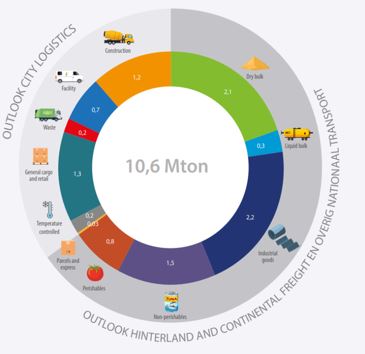Electrified urban freight delivery and other sustainable options for last mile delivery can be promising climate and energy solutions to reduce emissions coming from logistics, in the effort to contribute to low-emission zones as these are now envisaged in a number of cities. Solutions such as shifting to electric vans, micro-depots with zero-emission last-mile deliveries, cargo bikes, or even implementing a hub for a certain freight flow can be developed for various sub-sectors within urban freight (e.g. retail, parcels, etc.). Such actions or policies can bring significant effects in terms of energy consumption and reducing CO2 in logistics which are useful to be measured by cities, also for them to be able to discuss with local urban logistics actors.

Outlook of city transport: logistics, hinterland and continental freight transport. Source: Topsector Logistics/TNO (2021).
There are tools that have been developed to measure such effects and assess the solutions. Specific modules for zero emission zones for city logistics, modelling all vehicle movements by light commercial vehicles and trucks that relate to trips in and around urban areas can be included. Within such modules, methods to map the size of urban logistics vehicle fleet and (de)compose this vehicle fleet regarding specific logistical segments (e.g. construction, retail, parcel, waste) and measure the impact in terms of kilometres and CO2-emissions (inside and outside the urban areas) can be used. The impact of tailored measures for the different segments with respect to a change in emissions, kilometres and vehicle types can be measured. Mapping the size and measuring the impact of potential measures could be done on a national, regional, urban or neighbourhood/building level.
Comments ()